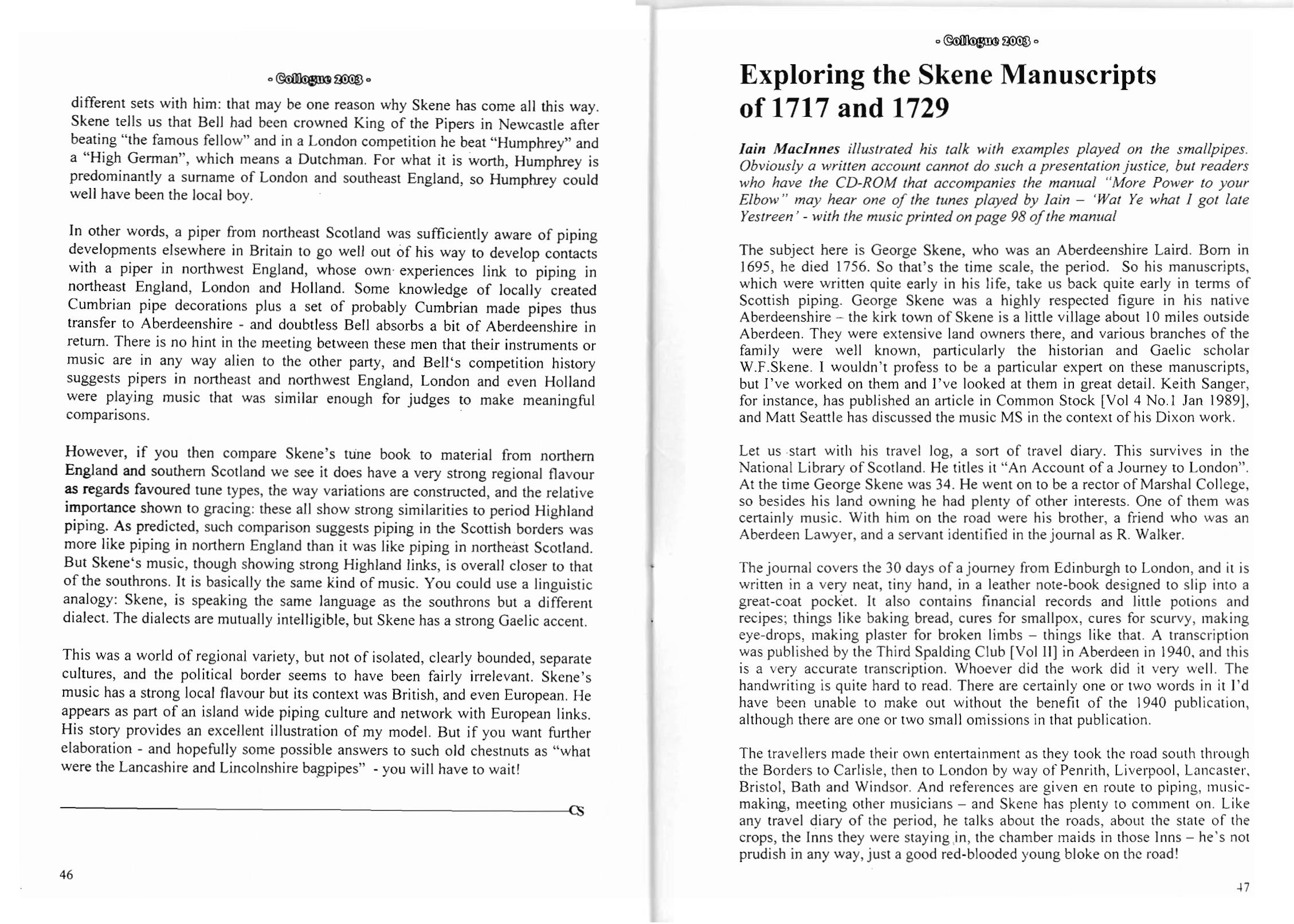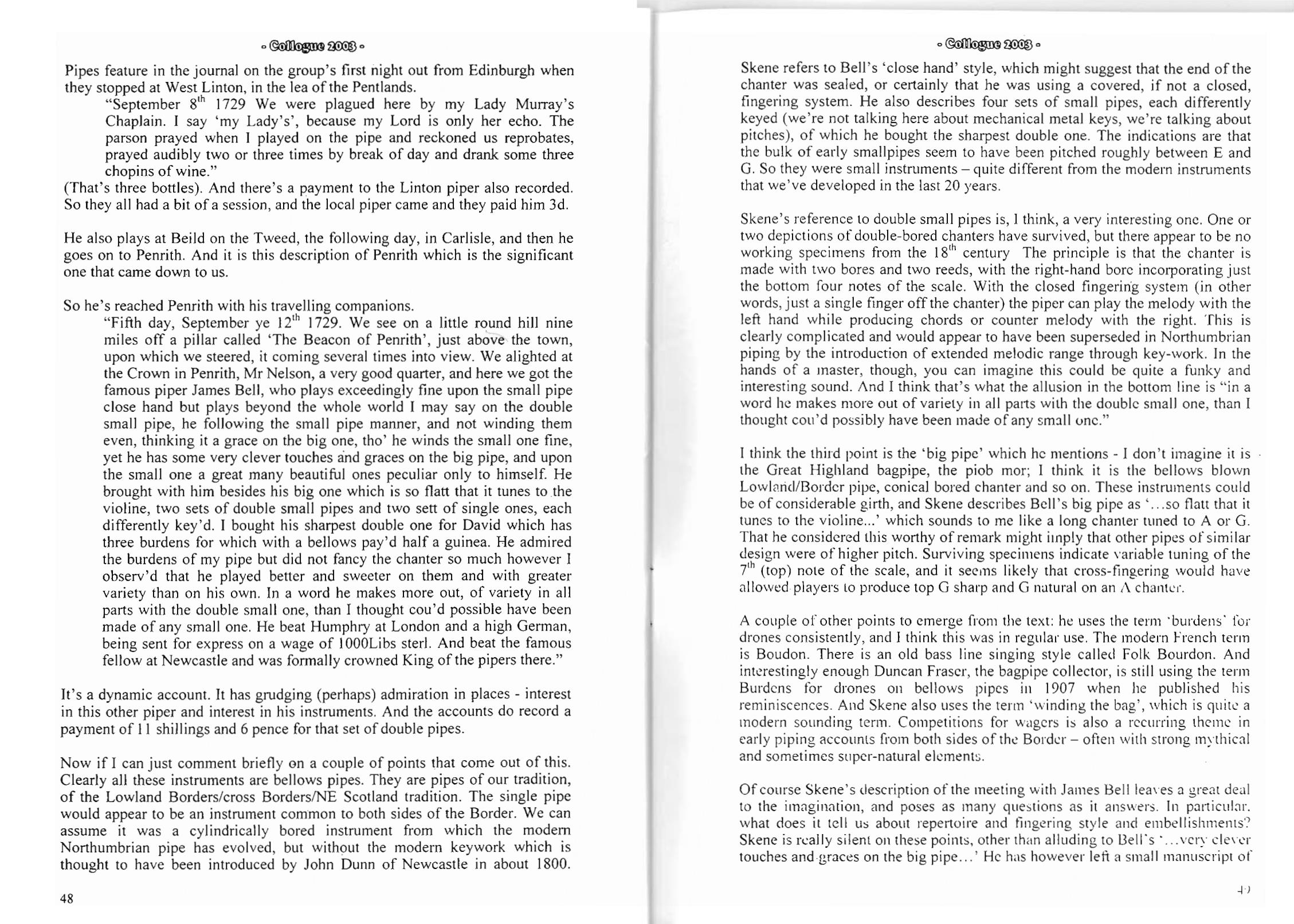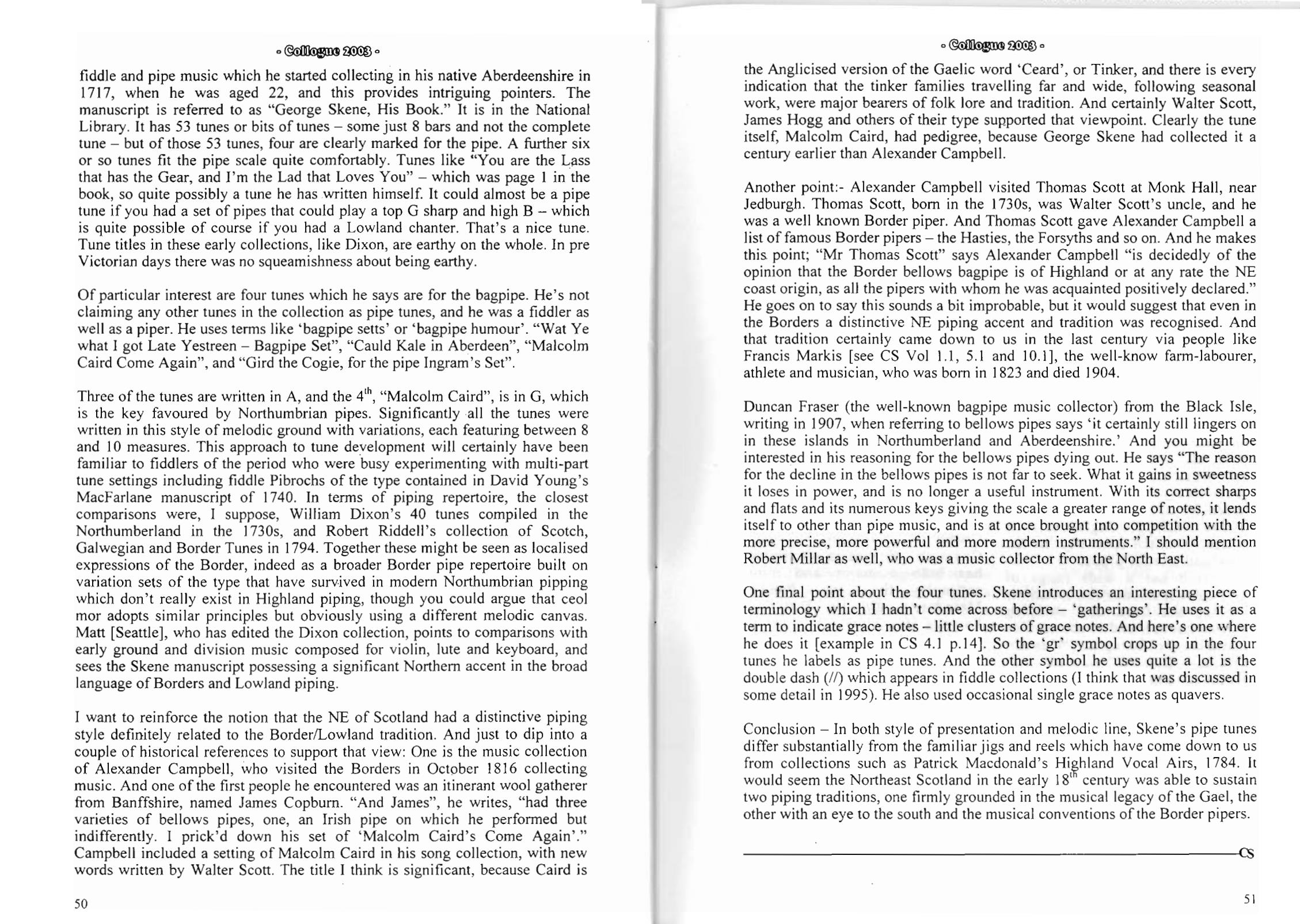Exploring the Skene Manuscripts



Iain MacInnes illustrated his talk with examples played on the smallpipes. Obviously a written account cannot do such a presentation justice, but readers who have the CD-ROM that accompanies the manual “More Power to your Elbow” may hear one of the tunes played by Iain - ‘Wat Ye what I got late Yestreen’ - with the music printed on page 98 of the manual
The subject here is George Skene, who was an Aberdeenshire Laird. Born in 1695, he died 1756. So that’s the time scale, the period. So his manuscripts, which were written quite early in his life, take us back quite early in terms of Scottish piping. George Skene was a highly respected figure in his native Aberdeenshire - the kirk town of Skene is a little village about 10 miles outside Aberdeen. They were extensive land owners there, and various branches of the family were well known, particularly the historian and Gaelic scholar W.F. Skene. I wouldn’t profess to be a particular expert on these manuscripts, but I’ve worked on them and I’ve looked at them in great detail. Keith Sanger, for instance, has published an article in Common Stock [Vol 4 No.1 Jan 1989], and Matt Seattle has dis- cussed the music MS in the context of his Dixon work.
Let us start with his travel log, a sort of travel diary. This survives in the National Library of Scotland. He titles it “An Account of a Journey to London”. At the time George Skene was
34. He went on to be a rector of Marshal College, so besides his land owning he had plenty of other interests. One of them was certainly music. With him on the road were his brother, a friend who was an Aberdeen Lawyer, and a servant identified in the journal as R. Walker.
The journal covers the 30 days of a journey from Edinburgh to London, and it is written in a very neat, tiny hand, in a leather note-book designed to slip into a great-coat pocket. It also contains financial records and little potions and recipes; things like baking bread, cures for smallpox, cures for scurvy, making eye-drops, making plaster for broken limbs - things like that. A transcription was published by the Third Spalding Club [Vol II] in Aberdeen in 1940, and this is a very accurate transcription. Whoever did the work did it very well. The hand- writing is quite hard to read. There are certainly one or two words in it I’d have been unable to make out without the benefit of the 1940 publication, although there are one or two small omissions in that publication.
The travellers made their own entertainment as they took the road south through the Bor- ders to Carlisle, then to London by way of Penrith, Liverpool, Lancaster, Bristol, Bath and Windsor. And references are given en route to piping, music-making, meeting other musi- cians - and Skene has plenty to comment on. Like any travel diary of the period, he talks about the roads, about the state of the crops, the Inns they were staying in, the chamber maids in those Inns - he’s not prudish in any way, just a good red-blooded young bloke on the road!
Pipes feature in the journal on the group’s first night out from Edinburgh when they stopped at West Linton, in the lea of the Pentlands.
“September 8th 1729 We were plagued here by my Lady Murray’s Chaplain. I say ‘my Lady’s’, because my Lord is only her echo. The parson prayed when I played on the pipe and reckoned us reprobates, prayed audibly two or three times by break of day and drank some three chopins of wine.”
(That’s three bottles). And there’s a payment to the Linton piper also recorded. So they all had a bit of a session, and the local piper came and they paid him 3d.
He also plays at Beild on the Tweed, the following day, in Carlisle, and then he goes on to Penrith. And it is this description of Penrith which is the significant one that came down to us.
So he’s reached Penrith with his travelling companions.
“Fifth day, September ye 12th 1729. We see on a little round hill nine miles off a pillar called ‘The Beacon of Penrith’, just above the town, upon which we steered, it coming several times into view. We alighted at the Crown in Penrith, Mr Nelson, a very good quarter, and here we got the famous piper James Bell, who plays exceedingly fine upon the small pipe close hand but plays beyond the whole world I may say on the double small pipe, he following the small pipe manner, and not winding them even, thinking it a grace on the big one, tho’ he winds the small one fine, yet he has some very clever touches and graces on the big pipe, and upon the small one a great many beautiful ones peculiar only to himself. He brought with him besides his big one which is so flatt that it tunes to the violine, two sets of double small pipes and two sett of single ones, each differently key’d. I bought his sharpest double one for David which has three burdens for which with a bellows pay’d half a guinea. He admired the burdens of my pipe but did not fancy the chanter so much however I observ’d that he played better and sweeter on them and with greater variety than on his own. In a word he makes more out, of va- riety in all parts with the double small one, than I thought cou’d possible have been made of any small one. He beat Humphry at London and a high German, being sent for express on a wage of 1000Libs sterl. And beat the famous fellow at Newcastle and was formally crowned King of the pipers there.”
It’s a dynamic account. It has grudging (perhaps) admiration in places - interest in this other piper and interest in his instruments. And the accounts do record a payment of 11 shillings and 6 pence for that set of double pipes.
Now if I can just comment briefly on a couple of points that come out of this. Clearly all these instruments are bellows pipes. They are pipes of our tradition, of the Lowland Bor- ders/cross Borders/NE Scotland tradition. The single pipe would appear to be an instrument common to both sides of the Border. We can assume it was a cylindrically bored instrument from which the modern Northumbrian pipe has evolved, but without the modern keywork which is thought to have been introduced by John Dunn of Newcastle in about 1800.
Skene refers to Bell’s ‘close hand’ style, which might suggest that the end of the chanter was sealed, or certainly that he was using a covered, if not a closed, fingering system. He also describes four sets of small pipes, each differently keyed (we’re not talking here about mechanical metal keys, we’re talking about pitches), of which he bought the sharpest dou- ble one. The indications are that the bulk of early smallpipes seem to have been pitched roughly between E and G. So they were small instruments - quite different from the modern instruments that we’ve developed in the last 20 years.
Skene’s reference to double small pipes is, I think, a very interesting one. One or two depic- tions of double-bored chanters have survived, but there appear to be no working specimens from the 18th century. The principle is that the chanter is made with two bores and two reeds, with the right-hand bore incorporating just the bottom four notes of the scale. With the closed fingering system (in other words, just a single finger off the chanter) the piper can play the melody with the left hand while producing chords or counter melody with the right. This is clearly complicated and would appear to have been superseded in Northum- brian piping by the introduction of extended melodic range through key-work. In the hands of a master, though, you can imagine this could be quite a funky and interesting sound. And I think that’s what the allusion in the bottom line is “in a word he makes more out of variety in all parts with the double small one, than I thought cou’d possibly have been made of any small one.”
I think the third point is the ‘big pipe’ which he mentions -I don’t imagine it is the Great Highland bagpipe, the piob mor; I think it is the bellows blown Lowland/Border pipe, coni- cal bored chanter and so on. These instruments could be of considerable girth, and Skene describes Bell’s big pipe as ‘...so flatt that it tunes to the violine...’ which sounds to me like a long chanter tuned to A or G. That he considered this worthy of remark might imply that other pipes of similar design were of higher pitch. Surviving specimens indicate variable tuning of the 7th (top) note of the scale, and it seems likely that cross-fingering would have allowed players to produce top G sharp and G natural on an A chanter.
A couple of other points to emerge from the text: he uses the term ‘burdens’ for drones con- sistently, and I think this was in regular use. The modern French term is Boudon. There is an old bass line singing style called Folk Bourdon. And interestingly enough Duncan Fraser, the bagpipe collector, is still using the term Burdens for drones on bellows pipes in 1907 when he published his reminiscences. And Skene also uses the term ‘winding the bag’, which is quite a modern sounding term. Competitions for wagers is also a recurring theme in early piping accounts from both sides of the Border - often with strong mythical and sometimes super-natural elements.
Of course Skene’s description of the meeting with James Bell leaves a great deal to the imagination, and poses as many questions as it answers. In particular, what does it tell us about repertoire and fingering style and embellishments'? Skene is really silent on these points, other than alluding to Bell's ‘..very clever touches and graces on the big pipe... ’ He has however left a small manuscript of fiddle and pipe music which he started collecting in
his native Aberdeenshire in 1717, when he was aged 22, and this provides intriguing point- ers. The manuscript is referred to as “George Skene, His Book.” It is in the National Li- brary. It has 53 tunes or bits of tunes - some just 8 bars and not the complete tune - but of those 53 tunes, four are clearly marked for the pipe. A further six or so tunes fit the pipe scale quite comfortably. Tunes like “You are the Lass that has the Gear, and I’m the Lad that Loves You” - which was page 1 in the book, so quite possibly a tune he has written himself. It could almost be a pipe tune if you had a set of pipes that could play a top G sharp and high B - which is quite possible of course if you had a Lowland chanter. That’s a nice tune. Tune titles in these early collections, like Dixon, are earthy on the whole. In pre Victorian days there was no squeamishness about being earthy.
Of particular interest are four tunes which he says are for the bagpipe. He’s not claiming any other tunes in the collection as pipe tunes, and he was a fiddler as well as a piper. He uses terms like ‘bagpipe setts’ or ‘bagpipe humour’. “Wat Ye what I got Late Yestreen - Bagpipe Set”, “Cauld Kale in Aberdeen”, “Malcolm Caird Come Again”, and “Gird the Cogie, for the pipe Ingram’s Set”.
Three of the tunes are written in A, and the 4th, “Malcolm Caird”, is in G, which is the key favoured by Northumbrian pipes. Significantly all the tunes were written in this style of me- lodic ground with variations, each featuring between 8 and 10 measures. This approach to tune development will certainly have been familiar to fiddlers of the period who were busy experimenting with multi-part tune settings including fiddle Pibrochs of the type contained in David Young’s MacFarlane manuscript of 1740. In terms of piping repertoire, the closest comparisons were, I suppose, William Dixon’s 40 tunes compiled in the Northumberland in the 1730s, and Robert Riddell’s collection of Scotch, Galwegian and Border Tunes in 1794. Together these might be seen as localised expressions of the Border, indeed as a broader Border pipe repertoire built on variation sets of the type that have survived in modem Northumbrian piping which don’t really exist in Highland piping, though you could argue that ceol mor adopts similar principles but obviously using a different melodic canvas. Matt [Seattle], who has edited the Dixon collection, points to comparisons with early ground and division music composed for violin, lute and keyboard, and sees the Skene manuscript pos- sessing a significant Northern accent in the broad language of Borders and Lowland piping.
I want to reinforce the notion that the NE of Scotland had a distinctive piping style defi- nitely related to the Border/Lowland tradition. And just to dip into a couple of historical references to support that view: One is the music collection of Alexander Campbell, who visited the Borders in October 1816 collecting music. And one of the first people he encountered was an itinerant wool gatherer from Banffshire, named James Copburn. “And James”, he writes, “had three varieties of bellows pipes, one, an Irish pipe on which he performed but indifferently. I prick’d down his set of ‘Malcolm Caird’s Come Again’.” Campbell included a setting of Malcolm Caird in his song collection, with new words writ- ten by Walter Scott. The title I think is significant, because Caird is the Anglicised version of the Gaelic word ‘Ceard’, or Tinker, and there is every indication that the tinker families travelling far and wide, following seasonal work, were major bearers of folk lore and trad-
-ition. And certainly Walter Scott, James Hogg and others of their type supported that view- point. Clearly the tune itself, Malcolm Caird, had pedigree, because George Skene had collected it a century earlier than Alexander Campbell.
Another point:- Alexander Campbell visited Thomas Scott at Monk Hall, near Jedburgh. Thomas Scott, born in the 1730s, was Walter Scott’s uncle, and he was a well known Border piper. And Thomas Scott gave Alexander Campbell a list of famous Border pipers - the Hasties, the Forsyths and so on. And he makes this point; “Mr Thomas Scott” says Alexan- der Campbell “is decidedly of the opinion that the Border bellows bagpipe is of Highland or at any rate the NE coast origin, as all the pipers with whom he was acquainted positively declared.” He goes on to say this sounds a bit improbable, but it would suggest that even in the Borders a distinctive NE piping accent and tradition was recognised. And that tradition certainly came down to us in the last century via people like Francis Markis [see CS Vol 1.1, 5.1 and 10.1], the well-know farm-labourer, athlete and musician, who was born in 1823 and died 1904.
Duncan Fraser (the well-known bagpipe music collector) from the Black Isle, writing in 1907, when referring to bellows pipes says ‘it certainly still lingers on in these islands in Northumberland and Aberdeenshire.’ And you might be interested in his reasoning for the bellows pipes dying out. He says “The reason for the decline in the bellows pipes is not far to seek. What it gains in sweetness it loses in power, and is no longer a useful instrument. With its correct sharps and flats and its numerous keys giving the scale a greater range of notes, it lends itself to other than pipe music, and is at once brought into competition with the more precise, more powerful and more modern instruments.” I should mention Robert Millar as well, who was a music collector from the North East.
One final point about the four tunes. Skene introduces an interesting piece of terminology which I hadn’t come across before - ‘gatherings’. He uses it as a term to indicate grace notes - little clusters of grace notes. And here’s one where he does it [example in CS 4.1 p. 14]. So the ‘gr’ symbol crops up in the four tunes he labels as pipe tunes. And the other symbol he uses quite a lot is the double dash (//) which appears in fiddle collections (I think that was discussed in some detail in 1995). He also used occasional single grace notes as quavers.
Conclusion - In both style of presentation and melodic line, Skene’s pipe tunes differ sub- stantially from the familiar jigs and reels which have come down to us from collections such as Patrick Macdonald’s Highland Vocal Airs, 1784. It would seem the Northeast Scot- land in the early 18th century was able to sustain two piping traditions, one firmly grounded in the musical legacy of the Gael, the other with an eye to the south and the musical conven-ions of the Border pipers.
